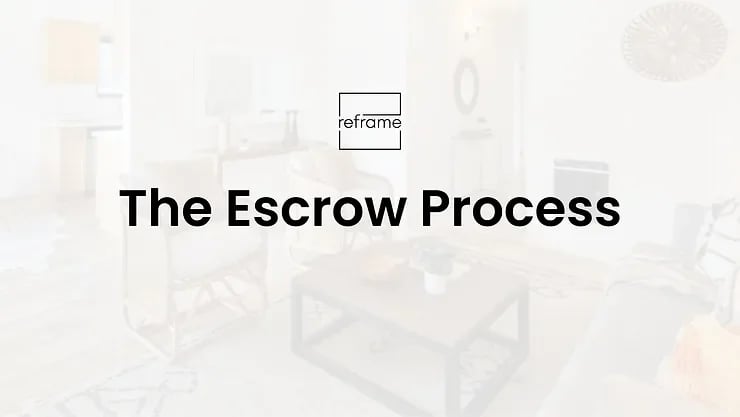Here’s the Reframe's Guide to the Escrow Process
So your offer has been accepted or you’re looking to get a feel for the escrow process. This guide will serve as a home base to follow along on the process and answer some of your questions. You can always ask the Reframe team for any help along the way!
Step 1: Open Escrow
What is escrow? The escrow process is the period of time from when your offer is accepted to when we close on your home. When we refer to “escrow” we’re usually talking about the company that is managing the escrow process or the process “escrow” itself. “That’s a good question for escrow.” or “Congrats! We’ve opened escrow!”
Escrow starts from day 0 — the day that your offer is accepted. Each day after starts the count from 0, 1, 2 …
The seller’s escrow company will reach out to our team for your information, we’ll share it, and they will reach out to you directly to tell you where to wire your earnest money deposit (the 3% good faith deposit). Make sure to do this ASAP to avoid any delays.
Escrow is part of your closing costs. You’re paying them to help manage the sale, so you can utilize them as a resource, too.
Step 2: Schedule Inspection (if applicable)
In the Bay Area, sellers typically provide the inspection reports up front. However, there are times when they don’t. We always recommend having an inspection so you know what home you are getting. An inspector will tell you the major (if any) and minor issues with the property. They may also tell you how to upkeep your property in the future. Inspections usually take anywhere from 90 minutes for a small condo to 3 hours for a 3,000 sqft home. We typically schedule the inspection within the first few days after getting your offer accepted.
Finding an Inspector
Below are the inspectors I would recommend. Yelp can also be really helpful in finding an inspector.
-
A+ Home Inspectors: Spencer Short // Website — (510) 545–4147 (home inspection)
-
Brother’s Inspections // Yelp — (925) 724–9433 (pest inspection)
-
West Valley Structural // Yelp — (650) 737–0527 (home & pest inspection) — only SF / Peninsula
These are general inspectors. If there is anything in particular you would like to check on the home, we will need a specialist. I recommend scheduling these right at the beginning of escrow.
Step 3: Submit EMD
Make sure to connect with escrow before wiring your funds. Be aware of wire fraud. ALWAYS call escrow before sending a deposit.
Step 4: Escrow Docs
Escrow will send you a group of documents within a few days of opening escrow. Heads up — escrow does NOT send these documents to your agent. We don’t see these unless you send them to us, so often, if you have escrow document questions, we recommend asking the escrow company. The most common question I hear is about how to take title. Here are a few resources I found online that help you determine how you would like to hold title of your home.
Step 5: Disclosures and Advisories
In every sale of residential property in California, there are disclosures and advisories that are required to be sent to buyers and sellers as part of the sale. You even signed some of these when we sent the Offer Agreement.
Now that you’ve opened escrow, there’s more! There are the California specific ones — you can tell it’s them because they look just like the offer agreement you signed. There are also brokerage specific advisories. Compass sends out specific disclosures and advisories to every sale done via a Compass agent. Most of these docs came about because of an incident at some point in time. Every brokerage has them. My transaction coordinator will send all of these to you via DocuSign so you don’t need to sign it by hand.
There are also Seller Disclosures. These are important to read through. These disclosures are directly from the seller. It’s everything that can remember about the home that you should know. There’s the Seller Property Questionnaire and the Transfer Disclosure Statement. These are the 2 disclosures that are part of your investigation contingency.
If the home you are buying is in an HOA. HOA docs are a set of CC&Rs that will be sent to you directly from escrow. You have an HOA contingency separate from the investigation contingency. Read through these documents to make sure the HOA fits what you’re looking for.
Natural Hazard Report — Escrow will order a natural hazard report. Read through this to ensure you are aware of any natural hazard zones the property may be in.
Title Report — Escrow will order a preliminary title report through a title company. Title is used to make sure you buy your property free and clear without any liens and get a clean title when the property is transferred in your name. When you receive this document, please read through the report and keep an eye out for zoning codes and any easements if applicable.
Step 6: Having the Inspection (if applicable)
The inspection can be time-consuming. We would love to see you there the whole time, but usually, most buyers come for the last hour. This is a perfect time for you to take measurements and study the layout so you can start furniture planning. At the end of the inspection, the inspector will do a verbal overview of what they found. Everything mentioned will be on the report, but we do recommend being there to hear it so you can ask questions.
Most commonly, outlets are substandard. They need to be upgraded to GFCI’s. Sometimes buyers might not understand what that means when they read it on the report, or what the usual cost is. The GFCI plate is $15 and the replacement can be $100–150 of labor. It’s a small fix that almost all homes need.
Step 7: Request for Repair (if applicable)
Most buyers since 2020 have not had the opportunity to request repairs or repair credit from the seller. It’s a seller’s market and sellers typically have an easy time countering that out in the negotiation process. It’s also a way that buyers make themselves stand out in their offer. We see a request for repair in about 1 of every 12 or 13 buyers.
If you are the lucky buyer that does get a request for repair, here are your next steps after receiving the inspection report.
-
review the inspection report
-
Write down the corresponding numbers of the issues you would like the seller to address in a text or email to me and my team. We’ll gather the information from the report, we would just like to see which items you would like to address.
-
We’ll review the list and make sure it is a strong list of requests. Sometimes asking for items that aren’t safety issues pushes a seller to decline the entire request (like painting a wall). Our goal is to get you the best bottom line.
-
We’ll draft up a request for repair. If you have a cost per item in mind, or a credit amount you would like to ask for, send it to us. Otherwise, we’ll work on estimating prices the best we can.
-
We’ll send the RR(request for repair) over for signature. You can review the items and the pricing we found and sign if it all looks good.
-
Our team will send the RR and inspection report to the listing agent. We should hear a response within 2 days.
Step 8: Investigation Contingency Removal
If the appraisal comes in higher than your purchase price, we don't say anything.
If the appraisal comes in at the purchase price - we're good to go! We can remove the appraisal contingency.
If the appraisal comes in below the purchase price and we have the appraisal contingency, we can renegotiate.
Heads up - in these situations, sellers typically don't want to do a request for repair because they're always feeling that they've given you a discount on the home. But we can always do our best to negotiate! Sometimes a seller will ask you to cover at least some of the gap, other times they won't. A seller can also choose not to lower the price, leaving buyers to decide if they want to cover the gap or back out of escrow.
Step 9: Appraisal Contingency
If you have an appraisal contingency, we need to wait until we get the appraisal report back from the Appraiser.
If the appraisal comes in higher than your purchase price, we don’t say anything.
If the appraisal comes in at the purchase price — we’re good to go! We can remove the appraisal contingency.
If the appraisal comes in below the purchase price and we have the appraisal contingency, we can renegotiate. Heads up — in these situations, sellers typically don’t want to do a request for repair because they’re always feeling that they’ve given you a discount on the home. But we can always do our best to negotiate! Sometimes a seller will ask you to cover at least some of the gap, other times they won’t. A seller can also choose not to lower the price, leaving buyers to decide if they want to cover the gap or back out of escrow.
Step 10: Loan Contingency
You'll be working closely with the lender to provide any additional documents needed to get the loan approved. If we have a loan contingency, the lender to give you the green light to remove the loan contingency. Getting all your docs in ASAP is important to make sure we can remove the loan contingency on time.
Loan contingency is typically the last one removed.
Step 11: Verification of Property (Final Walkthrough)
Within 5 days of closing escrow, buyers have the option to do one final walk-through to make sure everything is looking good. If the home was staged or occupied before, by this time all of the furniture and staging should be removed (but not always) so you can see the home completely empty!
If there is something wrong, we can take it to the listing agent to talk with the seller. This is unusual, but it does happen! One time the seller took the appliances even though we included them in the contract!







